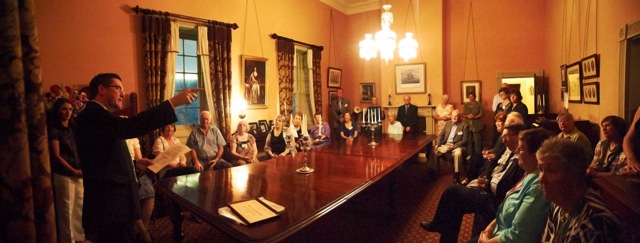Bruce is an independent public historian, who works on small contracts (mainly in the heritage field). He is currently working (on his longest-running contract, that is more than 6 months!) with the Sydney Harbour Foreshore Authority, reviewing and writing conservation plans (with an emphasis on history) for public domain spaces around The Rocks. See greenplaquesnsw.wordpress.com. He is also a PhD candidate in the Sydney University History Department, researching a cultural history of the crown in Australia.
What made you decide to pursue a career in history?
I have had a life-long fascination with history, probably from family history, growing up with a lot of old people, all storytellers, including a great-grandfather who was the son of a convict, and a boyhood in the Abrolhos Islands surrounded by four centuries of shipwreck relics and stories. Over the last few years I have been lucky enough to work, as a historian, in NSW’s three 1788 towns of Sydney Cove, Kingston (NI) and Parramatta. Being a historian was the only thing I ever really wanted to be (although I have had many, many other jobs), and it took me a long time to work out how to earn an income from a passion. I’m still not sure if I’ve got that right but I do manage to pay the rent!
Who is the audience for your history?
For my paid work, whoever has commissioned me. That usually means some sort of government agency, with the work feeding into either implementing or formulating public policy. Material that I publish on my historymatrix.wordpress.com blog is for other historians and researchers who may find it useful in their own work. I think that research hoarded rather than shared is wasted.
What’s your favourite historical source, book, website or film?
Heraldry: both as an unwritten form of communication and for the huge aesthetic variety of designs that can be produced from a few simple rules. For some 800 years heraldry has been a means of conveying information about identity, social status, allegiance, lineage, community and all sorts of other social and political relationships. Most cultures have some comparable system of heritable symbols, so a historian can use heraldry to build bridges between cultures and across times. The skills involved in ‘reading heraldry’ might seem arcane, but they provide insights into understanding visual clues and records in the past and today. A historical subject that includes something heraldic always gets an extra tick from me!
If you had a time machine, where would you go?
The future. I love science fiction, especially writers such as Terry Dowling, Trent Jamieson, Philip K. Dick, Isaac Asimov, China Miéville, writers who can evoke ‘future history’ and show the endless potentials for the future. I’m also a Randolph Stow fan, so another time machine journey would be to have a conversation (or several) with this reclusive bard. A visit to Mervyn Peake’s fantastical Gormenghast would also be brilliant. I really need a tardis and the regenerative capacity of Dr Who to get anywhere near all the times I want visit!
Why is history important today?
For its capacity to provoke reflection and contemplation, to understand that the present is a just a point in a continuum of past-present-future, that nothing is really preordained or inevitable. A sense of history, that things change over time and that there are also enduring resonances, helps counter the disempowerment of cynicism; it frees people to act. History shows us there are always other ways to see things, other questions to ask, that we chose our histories as much as we choose our futures. History is also important as good story-telling, which is probably at the heart of all cultures and civilizations, helping people to comprehend that they are part of something bigger and more satisfying beyond their own personal desires. Without historians, communities are inhibited in developing a sense of common purpose and identity. We help our communities to navigate stormy waters and find safe harbours, to face adversity and grow through renewal.

PHA (NSW & ACT) is lucky to have such a thoughtful president at the moment! I can’t say I share Bruce’s love of sci fi but then he might not be enamoured with 19th century British and Russian authors!
Great to hear what you’d up to Bruce, and to have some more insight into why heraldry fascinates you so. Like Pauline, I’ve never been a big fan of sci-fi – but recently have been thinking that the history of the future is a really captivating topic, and would love to come along in your tardis for a trip some time if you’re taking passengers.
The Doctor never travels alone!
Thanks Bruce – most interesting. I really like your statement that a sense of history helps counter the disempowerment of cynicism; it frees people to act.
A few people have asked me about the location in the picture. It is in the dining room of Government House on Norfolk Island, built 1804, burnt down 1814, ‘restored’ (as they said at the time) in 1829, and several more times since, most recently 1988. The big dining table is made of NSW red cedar, c1830, and somehow survived in that room ever since (basically, it was too big for anyone to be able to get it out again!), has lots of interesting historical grafitti and initials scratched into it. That Government House is, as I now know from the world heritage nomination work, the oldest vice-regal residence in Australia, in the Commonwealth (and therefore the world) that is still used for its original purpose. There is usually a public open-day once a month, so if you’re visiting the island at such a time, a visit is well worth while.